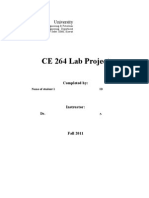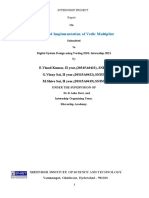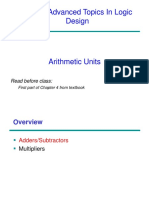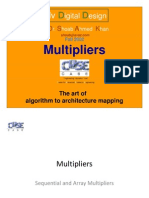Booth Encoder
Uploaded by
Thahsin ThahirBooth Encoder
Uploaded by
Thahsin ThahirISSN (Print) : 2320 3765
ISSN (Online): 2278 8875
International Journal of Advanced Research in Electrical,
Electronics and Instrumentation Engineering
(An ISO 3297: 2007 Certified Organization)
Vol. 3, Issue 8, August2014
FPGA Implementation of Low Power Booth
Multiplier Using Radix-4 Algorithm
Prof. V.R.Raut1, P. R. Loya2
Dept .of Electronics &Telecommunication Prof. Ram Meghe Institute of Technology and Research Badnera, Amravati,
Maharashtra, India1
Lecturer Dept .of Electronics &Communication, LAM Institute Of Technology, Dhamangaon (Rly), Maharashtra,
India2
ABSTRACT: As the scale of integration keeps growing, more and more sophisticated signal processing systems are
being implemented on a VLSI chip. These signal processing applications not only demand great computation capacity
but also consume considerable amounts of energy. While performance and area remain to be two major design goals,
power consumption has become a critical concern in todays VLSI system design. Multiplication is a fundamental
operation in most arithmetic computing systems. Multipliers have large area, long latency and consume considerable
power. Previous work on low-power multipliers focuses on low-level optimizations and has not considered well the
arithmetic computation features and application-specific data characteristics. Binary multiplier is an integral part of the
arithmetic logic unit (ALU) subsystem found in many processors. Booth's algorithm and others like Wallace-Tree
suggest techniques for multiplying signed numbers that works equally well for both negative and positive multipliers.
This synopsis proposes the design and implementation of Booth multiplier using VHDL . This compares the
power consumption and delay of radix 2 and modified radix 4 Booth multipliers. The modified radix 4 Booth
multiplier has reduced power consumption than the conventional radix 2 Booth Multiplier.
KEYWORDS:Radix2, Radix4 Booth Multiplier, Booth Algorithm
I.INTRODUCTION
Multiplication is an essential arithmetic operation and its applications are dated several decades back in time. Earlier
ALUs adders were used to perform the multiplication originally. As the applicationsof Array multipliers were
introduced the clock rates increased as well as timing constrains became austere. Ever since then methods to implement
multiplication are proposed which are more sophisticated [1-4]. As known the use of multiplication operation indigital
computing and digital electronics is very intense especially in the field of multimedia and digital signal processing
(DSP) applications [6]. There are mainly three stages to perform multiplication: The first stage mainly consists of
generating the partial products which are generated through an array of AND gates; Second stage consist of reducing
the partial products by the use of partial product reduction schemes; and finally the product is obtained by adding the
partial products [5]. The multiplication can be performed on: 1) Signed Numbers; 2) Unsigned Numbers. Signed
multiplication a binary number of either sign (two numbers whose sign may are not necessarily positive) may be
multiplied. But, in signed multiplication the sign-extension for negative multiplicands is not usable for negative
multipliers and there are large numbers ofsummands due to the large sequence of 1s in multiplier. Unsigned
multiplication binary number (whose sign is positive) is multiplied. Continuous advances of microelectronic
technologies make better useof energy, encode data more effectively, transmit information more reliable, etc.
Particularly, many of these technologies address low-power consumption to meet the requirements of various portable
applications [7]. In these application systems, a multiplier is a fundamental arithmetic unit andwidely used in circuits.
VHDL is one of the commontechniques for the digital system emergent process. The technique is done by program
using certain software which performs simulation and examination of the designed system. The designer only needs to
describe his digital circuit design in textual form which can remove without the effort to alter the hardware. VHDL is
more preferred because this technique can reduce cost and time, easy to troubleshoot, portable, a lot of platform
software support the VHDL function and high references availability. All the processes will be running using XilinxQuartus software which means the process is simulated only without any hardware implementation .Multiplication is a
Copyright to IJAREEIE
10.15662/ijareeie.2014.0308081
www.ijareeie.com
11479
ISSN (Print) : 2320 3765
ISSN (Online): 2278 8875
International Journal of Advanced Research in Electrical,
Electronics and Instrumentation Engineering
(An ISO 3297: 2007 Certified Organization)
Vol. 3, Issue 8, August2014
fundamental operation in most signals processing algorithms. Multipliers have large area, long latency and consume
considerable power. Therefore low-power multiplier design has been an important part in low- power VLSI system
design. Fast multipliers are essential parts of digital signal processing systems. The speed of multiplier operation is of
great importance in digital signal processing as well as in the general purpose processors today. The basic
multiplication principle is twofold i.e., evaluationof partial products and accumulation of the shifted partial products.
II.LITERATURE REVIEW & RELATED WORK
Multipliers are the key components of many high performance systems such as FIR filters [9], microprocessors, digital
signal processors, etc. A systems performance is generally determined by the performance of the multiplier because the
multiplier is generally the slowest clement in the system [10]. Furthermore, it is generally the most area consuming [11].
Hence, optimizing the speed and area of the multiplier is a major design issue. However, area and speed are usually
conflicting constraints so that improving speedresults mostly in larger areas. As a result, a whole spectrum of multipliers
with different area-speed constraints has been designed with fully parallel Multipliers at one end of the spectrum and
fully serial multipliers at the other end. In between are digit serial multipliers where single digits consisting of several
bits are operated on.
These multipliers have moderate performance in both speed and area. However, existing digit serial multipliers have
been plagued by complicated switching systems and/or irregularities in design. Radix- 2n [12] multipliers which operate
on digits in a parallel fashion instead of bits bring the pipelining to the digit level and avoid most of the above problems.
They were introduced by M. K. Ibrahim in 1993[8]
III.COMPLEMENT REPRESENTATION
In complement representation, numbers are represented as twos complement in the binary section. In this method,
positive number is represented in the same way as signed-magnitude method. It is most widely used method of
representation. Positive numbers are simply represented as a binary number with 0 as sign bit. To get negative number
convert all 0s to 1s, all 1s to 0s and then add 1 to it. Suppose, a number which are in 2s complement form and we
have to find its value in binary, then if number starts with 0 then it is a positive number and if number starts with 1
then it is a negative number. If, number is negative take the 2s complement of that number, we will get number in
ordinary binary. Let us take, 1101. Take the 2s complement then we will get 0011. As, number is started with 1 it is
negative number and 0011 is binary representation of positive 3. So, the number is -3. Similarly, we are representing
other negative numbers in 2s complement representation.
Suppose we are adding +5 and -5 in decimal we get 0. Now, represent these numbers in 2s complement form,
then we get +5 as 0101 and -5 as 1011. On adding these two numbers we get 10000. Discard carry, then the number is
represented as 0.In this signed multiplication we had modified the Complex Multiplication strategy.
A. Booths Recoding Algorithm
Parallel Multiplication using basic Booths Recoding algorithm is used to generate efficient partial product.
ThesePartial Products always have large number of bits than the input number of bits. This width of partial product is
usually depends upon the radix scheme used for recoding. These generated partial products are added by compressors.
So, these scheme uses less partial products which comprises low power and area.
There are two types of algorithm Radix-2 and Radix-4 to generate efficient partial products for multiplication. First we
will explain basic technique of Booths Recoding algorithm and then Modified Booths Recoding technique for Radix-2
algorithm.. Radix- 2n [12] multipliers which operate on digits in a parallel fashion instead of bits bring the pipelining to
the digit level and avoid most of the above problems. They were introduced by M. K. Ibrahim in 1993[8].
These structures are iterative and modular. The pipelining done at the digit level brings the benefit of constant
operation speed irrespective of the size of the multiplier. The clock speed is only determined by the digit size which is
already fixed before the design is implemented.
Copyright to IJAREEIE
10.15662/ijareeie.2014.0308081
www.ijareeie.com
11480
ISSN (Print) : 2320 3765
ISSN (Online): 2278 8875
International Journal of Advanced Research in Electrical,
Electronics and Instrumentation Engineering
(An ISO 3297: 2007 Certified Organization)
Vol. 3, Issue 8, August2014
IV.BASIC TECHNIQUE OF BOOTHS RECODING ALGORITHM FOR RADIX-2
Booth algorithm provides a procedure for multiplying binary integers in signed-2s complement representation [8].
According to the multiplication procedure, strings of 0s in the multiplier require no addition but just shifting and a string
of 1s in the multiplier from bit weight 2k to weight 2m can be treated as 2k+1 - 2m.
Booth algorithm involves recoding the multiplier first. In the recoded format, each bit in the multiplier can take any
of the three values: 0, 1 and -1.Suppose we want to multiply a number by 01110 (in decimal 14). This number can be
considered as the difference between 10000 (in decimal 16) and 00010 (in decimal 2). The multiplication by 01110 can
be achieved by summing up the following products:
i) 24 times the multiplicand (24 = 16)
ii) 2s complement of 21 times the multiplicand (21 = 2).
In a standard multiplication, three additions are required due to the string of three 1s.This can be replaced by one
addition and one subtraction. The above requirement is identified by recoding of the multiplier 01110 using the
following rules summarized in table 1.
Table 1. Radix-2 Recording Rules
Qn
Qn+1
Recorded Bits
Operations Performed
0
0
1
1
0
1
0
1
0
+1
-1
0
Shift
Add M
Subtract M
Shift
State diagram
The state diagram of the Radix-2 Booth multiplier is shown in Fig.1. Here we have four different types of states. For
00, 11 states we can perform multiplication of multiplicand with zero. For 01 state, we can multiply multiplicand with
one whereas for 10 state, we can multiply multiplicand with -1.
Fig. 1 State Diagram for Radix-2 Multiplier
ASM chart
The Fig.2 shows the ASM chart for Radix-2 booth multiplier. It represents conventional procedure for various
operations required with respect to state of machine. Here we generate the partial products by Radix-2 booth encoder.
By using this technique we can reduce the partial products generation and the computation time delay is less than
ordinary multiplication.
Copyright to IJAREEIE
10.15662/ijareeie.2014.0308081
www.ijareeie.com
11481
ISSN (Print) : 2320 3765
ISSN (Online): 2278 8875
International Journal of Advanced Research in Electrical,
Electronics and Instrumentation Engineering
(An ISO 3297: 2007 Certified Organization)
Vol. 3, Issue 8, August2014
Fig. 2 ASM chart for Radix-2 Booth Multiplier
To generate recoded multiplier for radix-2, following steps are to be performed.
i) Append the given multiplier with a zero to the LSB side.
ii) Make group of two bits in the overlapped way Recode the number using the above table.
Consider an example which has the 8 bit multiplicand as 11011001 and multiplier as 011100010.
Multiplicand
11011001
Multiplier
0 1 1 1 0 0 0 10
Recoded multiplier
+1 0 0 -10 0+1-1
000100111
111011001
000000000
000000000
000100111
000000000
000000000
1 1 1 0 1 1 0 0 1____________
Product
0000001001001001___
The peak power of a circuit can be defined as
max=Vdd.idd(t)dt
(1)
Where Vdd is the supply voltage and idd (t) is the amount of current drawn by the circuit at time.
Given this equation, minimization of the peak power at a given time is directly proportional to the amount of current
drawn at time. Since current is flowing ideally only when a circuit is active, by minimizing the number of simultaneously
active elements, we can reduce the spike in currentdrawn from the power supply, thus reducing the IR-voltage drop.
In order to optimize the peak power of a circuit, the number of circuit elements that are simultaneously switching
must be reduced.
Copyright to IJAREEIE
10.15662/ijareeie.2014.0308081
www.ijareeie.com
11482
ISSN (Print) : 2320 3765
ISSN (Online): 2278 8875
International Journal of Advanced Research in Electrical,
Electronics and Instrumentation Engineering
(An ISO 3297: 2007 Certified Organization)
Vol. 3, Issue 8, August2014
In this proposed work to realize high speed multipliers is to enhance parallelism which helps to decrease the
number of subsequent calculation stages. The original version of the Booth algorithm (Radix-2) had two drawbacks.
They are: 1) The number of add subtract operations and the number of shift operations becomes variable and becomes
inconvenient in designing parallel multipliers.(ii)The algorithm becomes inefficient when there are isolated 1s. These
problems are overcome by using modified Radix 4.Booth algorithm which scans strings of three bits is given below: 1)
Extend the sign bit 1 position if necessary to ensure that n is even.2) Append a 0 to the right of the LSB of the
multiplier.3) According to the value of each vector, each Partial Product will be 0, +M,-M, +2M or -2M.
The negative values of B are made by taking the 2s complement and in this paper Carry-look-ahead (CLA) fast
adders are used. The multiplication of M is done by shifting M by one bit to the left. Thus, in any case, in designing nbit parallel multiplier, only n/2 partial products are produced. The partial products are calculated according to the
following rule
Zn= -2Bn+1 + Bn +Bn-1
--------- (2)
Where B is the multiplier.
Table 2. Modified Radix-4 Recoding Rules
Zn
Partial Product
000
001
010
011
100
101
1
1
2
-2
-1
1x Multiplicand
1x Multiplicand
2x Multiplicand
-2x Multiplicand
-1x Multiplicand
110
111
-1
0
-1x Multiplicand
0
B. Booth Multiplication Algorithm for Radix-4
One of the solutions of realizing high speed multipliers is to enhance parallelism which helps to decrease the number of
subsequent calculation stages. The original version of the Booth algorithm (Radix-2) had two drawbacks. They are:
(i) the number of add subtract operations and the number of shift operations become variable and become inconvenient
in designing parallel multipliers. (ii) The algorithm becomes inefficient when there are isolated 1s. These problems are
overcome by using modified Radix-4 Booth multiplication algorithm. The design approach of Radix-4 algorithm is
described with the pictorial views of state diagram and ASM chart. This algorithm scans strings of three bits as follows:
1) Extend the sign bit 1 position if necessary to ensure that n is even.
2) Append a 0 to the right of the LSB of the multiplier.
3) According to the value of each vector, each Partial
Products will be 0, +y, -y, +2y or -2y. Radix-4 booth encoder performs the process of encoding the multiplicand based
on multiplier bits. It will compare 3 bits at a time with overlapping technique. Grouping starts from the LSB, and the
first block only uses two bits of the multiplier and assumes a zero for the third bit. The functional operation of Radix-4
booth encoder is shown in the Table 2. The state diagram of the Radix-4 Booth multiplier is shown in Fig.3. It consists
of eight different types of states and during these states we can obtain the outcomes, which are multiplication of
Copyright to IJAREEIE
10.15662/ijareeie.2014.0308081
www.ijareeie.com
11483
ISSN (Print) : 2320 3765
ISSN (Online): 2278 8875
International Journal of Advanced Research in Electrical,
Electronics and Instrumentation Engineering
(An ISO 3297: 2007 Certified Organization)
Vol. 3, Issue 8, August2014
multiplicand with 0,-1 and -2 consecutively. The pictorial view of the state diagram presents various logics to perform
the Radix-4 Booth multiplication in different states as per the adopting encoding technique.
State diagram
Fig.3. State diagram of Radix-4 Booth Multiplier
ASM chart
The ASM chart for Radix-4 booth multiplier is as shown inFig.4. This represents the conventional flow of operations
that are required for Radix-4 booth multiplier in various states. Here we can generate the partial products by Radix-4
booth encoder. By using this technique we can further reduce the partial products generation and the computation
time delay, which is less than that of Radix-2 multiplication.
Fig. 4 ASM chart for Radix-4 Booth Multiplier
Consider example for radix 4:
Multiplicand
10000001
Multiplier
011111100
Copyright to IJAREEIE
10.15662/ijareeie.2014.0308081
www.ijareeie.com
11484
ISSN (Print) : 2320 3765
ISSN (Online): 2278 8875
International Journal of Advanced Research in Electrical,
Electronics and Instrumentation Engineering
(An ISO 3297: 2007 Certified Organization)
Vol. 3, Issue 8, August2014
+2 0 0 -2
0000000011111110
00000000000000
000000000000
1100000010
Product
1100000101111110
V. RESULTS
We evaluate the performance of Radix-2 and Radix-4 booth multipliers and implement them on FPGA. For Design
Entry, we used ModelSim 6.3f and design with VHDL. In order to get the power report and delay report we synthesize
these multipliers using Xilinx ISE 9.1i. The comparison of synthesis report for Radix-2 and Radix-4 Booth multipliers
is given in Table 3.
VI. CONCLUSION
In this paper, the Radix-2 and Radix-4 booth multipliers are designed using VHDL. The delay and power dissipation of
modified radix-4 Booth multiplier is less as compared to the Radix-2 booth multiplier. When implemented on FPGA, it
is found that the radix-4 booth multiplier consumes less power than radix-2 booth multiplier. Also estimated delay is
less for radix-4 booth multiplier.
REFERENCES
[1] W. C. Yeh and C. W. Jen, High Speed Booth encoded Parallel Multiplier Design, IEEE transactions on computers, vol. 49, no. 7, pp. 692-701,
July 2000.
Copyright to IJAREEIE
10.15662/ijareeie.2014.0308081
www.ijareeie.com
11485
ISSN (Print) : 2320 3765
ISSN (Online): 2278 8875
International Journal of Advanced Research in Electrical,
Electronics and Instrumentation Engineering
(An ISO 3297: 2007 Certified Organization)
Vol. 3, Issue 8, August2014
[2] Shiann-RongKuang, Jiun-Ping Wang, and Cang-Yuan Guo, Modified Booth multipliers with a Regular Partial Product Array, IEEE
Transactions on circuits and systems-II, vol 56, No 5, May 2009.
[3] Li-Rong Wang, Shyh-JyeJou and Chung-Len Lee, A well-tructured Modified Booth Multiplier Design 978-1-4244-1617-2/08/$25.00 2008
IEEE.
[4] Soojin Kim and Kyeongsoon Cho Design of High-speed Modified Booth Multipliers Operating at GHz Ranges World Academy of Science,
Engineering and Technology 61 2010.
[5] Shiann-RongKuang, Member, IEEE, Jiun-Ping Wang, and Cang-Yuan Guo Modified Booth Multipliers With a Regular Partial Product Array
IEEE TRANSACTIONS ON CIRCUITS AND SYSTEMSII: EXPRESS BRIEFS, VOL. 56, NO. 5, MAY 2009 1549-7747
[6] Ravindra P Rajput and M. N ShanmukhaSwamy High speed Modified Booth Encoder multiplier for signed and unsigned numbers , 2012 14th
International Conference on Modelling and Simulation 978-0-7695-4682-7/12 2012 IEEE.
[7] A. P. Chandrakasan and R. W. Brodersen, Low-Power CMOS Design. Piscataway, NJ: IEEE Press, 1998.
[8]A. D. Booth, A Signed Binary Multiplication Technique, Quarterly J. Mechanical Applications in Math., vol. 4, part 2, pp.236-240,1951.
[9] John G.Proakis, Dimitris G. Monolakis, Digital Signal Processing,Principles,Algorithms, and Applications, Fourth Edition.
[10] A. Dandapat, S. Ghosal, P. Sarkar, D. Mukhopadhyay (2009), A 1.2-ns1616-Bit Binary Multiplier Using. High Speed Compressors,
International Journal of Electrical, Computer, and Systems Engineering, 2009, 234-239.
[11] J. Gu, C.H.Chang (2003), Ultra low voltage low power 4-2 compressor for high speed multiplications. Circuits and Systems,2003.ISCAS 03.
Proceedings of the International Symposium, vol. 5, May 2003, 321-324.
[12] Israel Koren, Computer arithmatics algorithms A.K.Peters Ltd. ISBN 1568811608.
[13] C.H.Chang, J.Gu, M.Zhang (2004) ,Ultra low-voltage low-power CMOS 4-2 and 5-2 compressors for fast arithmetic circuits,Circuits and
Systems Regular Papers, IEEE Transactions page(s): 1985- 1997, Volume: 51, Issue: 10, Oct. 2004.Rashmi Ranjan et al./ International Journal of
Computer Science & Engineering Technology (IJCSET)
Copyright to IJAREEIE
10.15662/ijareeie.2014.0308081
www.ijareeie.com
11486
You might also like
- WEBCUIF ImplementaGenILComponentandSimpleObjects HowtoGuide 230212 1241 122No ratings yetWEBCUIF ImplementaGenILComponentandSimpleObjects HowtoGuide 230212 1241 12221 pages
- Low Power Booth Multiplier Using Radix-4 Algorithm On Fpga: Prof. V. R. Raut, P. R. LoyaNo ratings yetLow Power Booth Multiplier Using Radix-4 Algorithm On Fpga: Prof. V. R. Raut, P. R. Loya5 pages
- Ijecet: International Journal of Electronics and Communication Engineering & Technology (Ijecet)No ratings yetIjecet: International Journal of Electronics and Communication Engineering & Technology (Ijecet)11 pages
- Design, Comparison and Implementation of Multipliers On FPGANo ratings yetDesign, Comparison and Implementation of Multipliers On FPGA8 pages
- Radix-4 and Radix-8 Multiplier Using Verilog HDLNo ratings yetRadix-4 and Radix-8 Multiplier Using Verilog HDL6 pages
- Radix-4 and Radix-8 Multiplier Using Verilog HDL: (Ijartet) Vol. 1, Issue 1, September 2014No ratings yetRadix-4 and Radix-8 Multiplier Using Verilog HDL: (Ijartet) Vol. 1, Issue 1, September 20146 pages
- Analysis and Comparison of Different Multiplier: Jasbir Kaur Sumit KumarNo ratings yetAnalysis and Comparison of Different Multiplier: Jasbir Kaur Sumit Kumar4 pages
- A New Vlsi Architecture of Parallel Multiplier Based On Radix-4 Modified Booth Algorithm Using VHDLNo ratings yetA New Vlsi Architecture of Parallel Multiplier Based On Radix-4 Modified Booth Algorithm Using VHDL8 pages
- Vlsi Architecture of Parallel Multiplier - Accumulator BasedNo ratings yetVlsi Architecture of Parallel Multiplier - Accumulator Based8 pages
- Booth Algorithm For The Design of Multiplier: Bhavya Lahari Gundapaneni, JRK Kumar DabbakutiNo ratings yetBooth Algorithm For The Design of Multiplier: Bhavya Lahari Gundapaneni, JRK Kumar Dabbakuti4 pages
- Design of High Performance Radix-4 and Radix-8 Multiplier Using Verilog HDLNo ratings yetDesign of High Performance Radix-4 and Radix-8 Multiplier Using Verilog HDL11 pages
- Design and Simulation of Radix-8 Booth Multiplier For Signed and Unsigned Numbers Using VHDLNo ratings yetDesign and Simulation of Radix-8 Booth Multiplier For Signed and Unsigned Numbers Using VHDL51 pages
- Design of Area, Power and Delay Efficient High-Speed MultipliersNo ratings yetDesign of Area, Power and Delay Efficient High-Speed Multipliers8 pages
- A Review of Different Methods For Booth Multiplier: Jyoti Kalia, Vikas MittalNo ratings yetA Review of Different Methods For Booth Multiplier: Jyoti Kalia, Vikas Mittal4 pages
- FPGA Implementation of Efficient ModifieNo ratings yetFPGA Implementation of Efficient Modifie4 pages
- EEE 270 Advanced Topics in Logic Design: Read Before ClassNo ratings yetEEE 270 Advanced Topics in Logic Design: Read Before Class35 pages
- Department of Electronics & Telecommunication Vivekanand Education Society'S Institute of Technology University of Mumbai 2018-2019 Report OnNo ratings yetDepartment of Electronics & Telecommunication Vivekanand Education Society'S Institute of Technology University of Mumbai 2018-2019 Report On10 pages
- Design of Modified Low Power Booth MultiplierNo ratings yetDesign of Modified Low Power Booth Multiplier6 pages
- Design of Low-Power and High Performance Radix-4 MultiplierNo ratings yetDesign of Low-Power and High Performance Radix-4 Multiplier4 pages
- The Efficient Implementation of An Array MultiplierNo ratings yetThe Efficient Implementation of An Array Multiplier5 pages
- Floating Point Multipliers: Simulation & Synthesis Using VHDLNo ratings yetFloating Point Multipliers: Simulation & Synthesis Using VHDL40 pages
- Implementation of ALU Using Modified Radix-4 Modified Booth MultiplierNo ratings yetImplementation of ALU Using Modified Radix-4 Modified Booth Multiplier15 pages
- International Journal of Computational Engineering Research (IJCER)No ratings yetInternational Journal of Computational Engineering Research (IJCER)11 pages
- Modified Booth Recoder For Efficient Add-Multiply Operator: A Project ReportNo ratings yetModified Booth Recoder For Efficient Add-Multiply Operator: A Project Report12 pages
- Efficient Implementation of Multiplier For Digital Fir Filters IJERTCONV3IS01019No ratings yetEfficient Implementation of Multiplier For Digital Fir Filters IJERTCONV3IS010195 pages
- DICD-Fall-2024-Lecture-09-Arithmetic-CircuitsNo ratings yetDICD-Fall-2024-Lecture-09-Arithmetic-Circuits52 pages
- 30 Fault Tolerant Parallel Filters Based On Error Correction CodesNo ratings yet30 Fault Tolerant Parallel Filters Based On Error Correction Codes6 pages
- Volume Booster: YT-300 / YT-310 / YT-305 / YT-315 / YT-320No ratings yetVolume Booster: YT-300 / YT-310 / YT-305 / YT-315 / YT-3201 page
- Project in Electronics and Circuit Design 1No ratings yetProject in Electronics and Circuit Design 114 pages
- It Ips 3110 Iu 2gc 4 Poe Datasheet - SWITCH ETHERNET POE INDUSTRIALNo ratings yetIt Ips 3110 Iu 2gc 4 Poe Datasheet - SWITCH ETHERNET POE INDUSTRIAL2 pages
- Oppo Find X: Teardown and Key Components IdentificationNo ratings yetOppo Find X: Teardown and Key Components Identification22 pages
- Successive Approximation ADC - Wikipedia, The Free EncyclopediaNo ratings yetSuccessive Approximation ADC - Wikipedia, The Free Encyclopedia4 pages
- Installation Instruction: Single Pole Insulated Conductor Rail Programme 812No ratings yetInstallation Instruction: Single Pole Insulated Conductor Rail Programme 8129 pages
- Donaldson Air Filter - P618932 - Donaldson Filters100% (1)Donaldson Air Filter - P618932 - Donaldson Filters3 pages
- Details of Advertisement and General TermsNo ratings yetDetails of Advertisement and General Terms5 pages
- Fiber Monthly Statement: This Month's SummaryNo ratings yetFiber Monthly Statement: This Month's Summary3 pages
- WEBCUIF ImplementaGenILComponentandSimpleObjects HowtoGuide 230212 1241 122WEBCUIF ImplementaGenILComponentandSimpleObjects HowtoGuide 230212 1241 122
- Low Power Booth Multiplier Using Radix-4 Algorithm On Fpga: Prof. V. R. Raut, P. R. LoyaLow Power Booth Multiplier Using Radix-4 Algorithm On Fpga: Prof. V. R. Raut, P. R. Loya
- Ijecet: International Journal of Electronics and Communication Engineering & Technology (Ijecet)Ijecet: International Journal of Electronics and Communication Engineering & Technology (Ijecet)
- Design, Comparison and Implementation of Multipliers On FPGADesign, Comparison and Implementation of Multipliers On FPGA
- Radix-4 and Radix-8 Multiplier Using Verilog HDL: (Ijartet) Vol. 1, Issue 1, September 2014Radix-4 and Radix-8 Multiplier Using Verilog HDL: (Ijartet) Vol. 1, Issue 1, September 2014
- Analysis and Comparison of Different Multiplier: Jasbir Kaur Sumit KumarAnalysis and Comparison of Different Multiplier: Jasbir Kaur Sumit Kumar
- A New Vlsi Architecture of Parallel Multiplier Based On Radix-4 Modified Booth Algorithm Using VHDLA New Vlsi Architecture of Parallel Multiplier Based On Radix-4 Modified Booth Algorithm Using VHDL
- Vlsi Architecture of Parallel Multiplier - Accumulator BasedVlsi Architecture of Parallel Multiplier - Accumulator Based
- Booth Algorithm For The Design of Multiplier: Bhavya Lahari Gundapaneni, JRK Kumar DabbakutiBooth Algorithm For The Design of Multiplier: Bhavya Lahari Gundapaneni, JRK Kumar Dabbakuti
- Design of High Performance Radix-4 and Radix-8 Multiplier Using Verilog HDLDesign of High Performance Radix-4 and Radix-8 Multiplier Using Verilog HDL
- Design and Simulation of Radix-8 Booth Multiplier For Signed and Unsigned Numbers Using VHDLDesign and Simulation of Radix-8 Booth Multiplier For Signed and Unsigned Numbers Using VHDL
- Design of Area, Power and Delay Efficient High-Speed MultipliersDesign of Area, Power and Delay Efficient High-Speed Multipliers
- A Review of Different Methods For Booth Multiplier: Jyoti Kalia, Vikas MittalA Review of Different Methods For Booth Multiplier: Jyoti Kalia, Vikas Mittal
- EEE 270 Advanced Topics in Logic Design: Read Before ClassEEE 270 Advanced Topics in Logic Design: Read Before Class
- Department of Electronics & Telecommunication Vivekanand Education Society'S Institute of Technology University of Mumbai 2018-2019 Report OnDepartment of Electronics & Telecommunication Vivekanand Education Society'S Institute of Technology University of Mumbai 2018-2019 Report On
- Design of Low-Power and High Performance Radix-4 MultiplierDesign of Low-Power and High Performance Radix-4 Multiplier
- The Efficient Implementation of An Array MultiplierThe Efficient Implementation of An Array Multiplier
- Floating Point Multipliers: Simulation & Synthesis Using VHDLFloating Point Multipliers: Simulation & Synthesis Using VHDL
- Implementation of ALU Using Modified Radix-4 Modified Booth MultiplierImplementation of ALU Using Modified Radix-4 Modified Booth Multiplier
- International Journal of Computational Engineering Research (IJCER)International Journal of Computational Engineering Research (IJCER)
- Modified Booth Recoder For Efficient Add-Multiply Operator: A Project ReportModified Booth Recoder For Efficient Add-Multiply Operator: A Project Report
- Efficient Implementation of Multiplier For Digital Fir Filters IJERTCONV3IS01019Efficient Implementation of Multiplier For Digital Fir Filters IJERTCONV3IS01019
- 30 Fault Tolerant Parallel Filters Based On Error Correction Codes30 Fault Tolerant Parallel Filters Based On Error Correction Codes
- Volume Booster: YT-300 / YT-310 / YT-305 / YT-315 / YT-320Volume Booster: YT-300 / YT-310 / YT-305 / YT-315 / YT-320
- It Ips 3110 Iu 2gc 4 Poe Datasheet - SWITCH ETHERNET POE INDUSTRIALIt Ips 3110 Iu 2gc 4 Poe Datasheet - SWITCH ETHERNET POE INDUSTRIAL
- Oppo Find X: Teardown and Key Components IdentificationOppo Find X: Teardown and Key Components Identification
- Successive Approximation ADC - Wikipedia, The Free EncyclopediaSuccessive Approximation ADC - Wikipedia, The Free Encyclopedia
- Installation Instruction: Single Pole Insulated Conductor Rail Programme 812Installation Instruction: Single Pole Insulated Conductor Rail Programme 812
- Donaldson Air Filter - P618932 - Donaldson FiltersDonaldson Air Filter - P618932 - Donaldson Filters








































































































